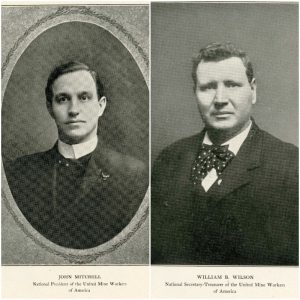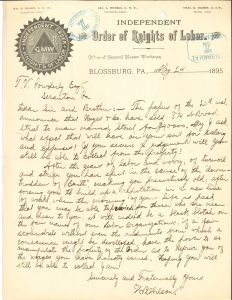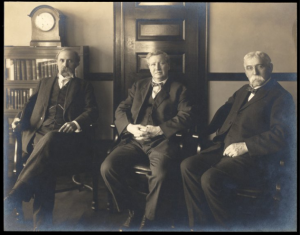
Scottish immigrant and Pennsylvania coal miner, William Bauchop (W. B.) Wilson (1862-1934), became the voice of workers speaking to power as a founder of the United Mine Workers of America (UMWA) union, the first representative for labor in Congress, and the first secretary of labor in the Woodrow Wilson (no relation) administration. Although not a Catholic, W.B. worked during the Gilded Age and Progressive era to advance labor’s cause along with many Catholics such as T. V. Powderly, John Mitchell, John W. Hayes, and ‘Mother’ Jones. Wilson’s papers reside with the Historical Society of Pennsylvania in Philadelphia, but his documentary trail is well represented in the papers of his Catholic colleagues at the Catholic University of America Archives, and the digital version available by subscription at The History Vault.
W. B.’s family settled in the tightly controlled coal company town of Arnot, Tioga County, in the mountains of northern Pennsylvania. In 1871, not yet 10, Wilson went to work in the mines. As a young man he began to organize his fellow workers, becoming blacklisted by mine owners, and thus working a series of jobs as lumberjack, mill hand, and railroad worker. Active in the Knights of Labor, where he was a supporter of leader Terence V. Powderly, as evidenced by his letter of March 5, 1895. W. B. was also a founder of the United Mine Workers of America (UMWA) in 1890, serving on their National Executive Board though he remained an active coal miner until 1898. He served as UMWA Secretary-Treasurer, 1900-1908, working closely with President John Mitchell as his “wise and sagacious counselor”¹ during the Great Anthracite Coal Strike of 1902, winning higher wages, shorter working days, and national recognition of the union. During this time he also became a colleague of celebrated labor activist, ‘the Miner’s Angel,’ Mary Harris ‘Mother’ Jones, who usually addressed him as “My Dear Comrade’ in her numerous letters.²

W. B. went on to serve three terms, March 4, 1907-March 3, 1913, as a Democratic congressman from Tioga County. In Congress, he introduced legislation creating the Bureau of Mines and established a Department of Labor, which included the Bureau of Labor Statistics that had been headed successively by Catholic University professors Carroll D. Wright and Charles P. Neill. In 1912, W. B. became chairman of the House Labor Committee but was defeated for a fourth term in Congress. However, incoming Democratic President, Woodrow Wilson appointed W. B. as Secretary of Labor, heading the department he had created from March 5, 1913, to March 5, 1921. There he conciliated numerous potential strikes, regulate working conditions for women, and during World War I created an employment service moving more than six million workers to places where workers were needed. He also worked to provide insurance for military members and housing and higher wages for war workers. W. B. also worked diligently to restrain excesses of Attorney-General A. Mitchell Palmer during ‘The Red Scare’ regarding Communist threats in 1919-1920.
W. B. left the Labor Department in 1921, where incidentally he had been reunited with his former Knights of Labor chief Powderly who now reported to the Secretary from his position as head of the department’s Information Bureau. Out of government, W. B. engaged in mining and agricultural pursuits near Blossburg, Tioga County. He made a foray back into politics for an unsuccessful run for the U. S. Senate in 1926. Thereafter, W. B. did some work as an arbiter in Illinois coal fields but otherwise lived in retirement until dying on a train returning from Florida near Savannah, Georgia, on May 25, 1934. He is buried beside his wife, fellow immigrant Agnes Williamson, whom he married in 1883, in Blossburg’s Arbon Cemetery, not far from other family members. He is remembered for speaking labor’s “truth to power.”³ He was also an occasional poet, poignantly expressing the immigrant’s longing in Memories (1916):

True, there stood Penn’s forest as stately as ever,
And, there, the wide meadows and tall growing grain,
And down in the valley the swift flowing river
Fast winding its way to the billowy main.
Yet though my heart loves them with loyal devotion,
My memory dwells on sweet visions of yore,
And pictures that country far over the ocean,
The land of my fathers, old Scotia’s loved shore.
Special thanks to the best online source for William B. Wilson: Blossburg.org. I also owe a personal debt to ‘Dunny’ Dunlap, an aged corner store owner in my hometown of Cherry Tree, Pennsylvania, who would regale me with stories about his wife’s uncle, W. B. Wilson.
¹ Craig Phelan. Divided Loyalties: The Public and Private Life of Labor Leader John Mitchell. State University of New York Press, 1994, p. 91, citing the United Mine Workers Journal of June 18, 1903.
² See Edward M. Steel (ed.) The Correspondence of Mother Jones. University of Pittsburgh Press, 1985.
³ To borrow an iconic phrase attributed to later civil rights leader Bayard Rustin.

Very nice piece on the father of the Department of Labor. I was a historian there from 1972 until 2006. I was hired by Chief Historian Jonathan Grossman. Thank you for sharing this fine piece. In return, I will share with you a brand new website that I developed in partnership with the Society for History in the Federal Government. It is called “History at the Federal Government.” It’s a portal to over 260 histories of federal departments, offices, and independent agencies. It is also a hub for 60+ federal historical resources. It is both an educational resource and a research tool. No less than Robert Reich, whom I worked under during his term as Secretary of Labor under Clinton, has declared it a tremendous resource. To see it, just enter shfg.org/history-at-fedgov. Let me know what you think of it. My contact infor is found on the “About” page.